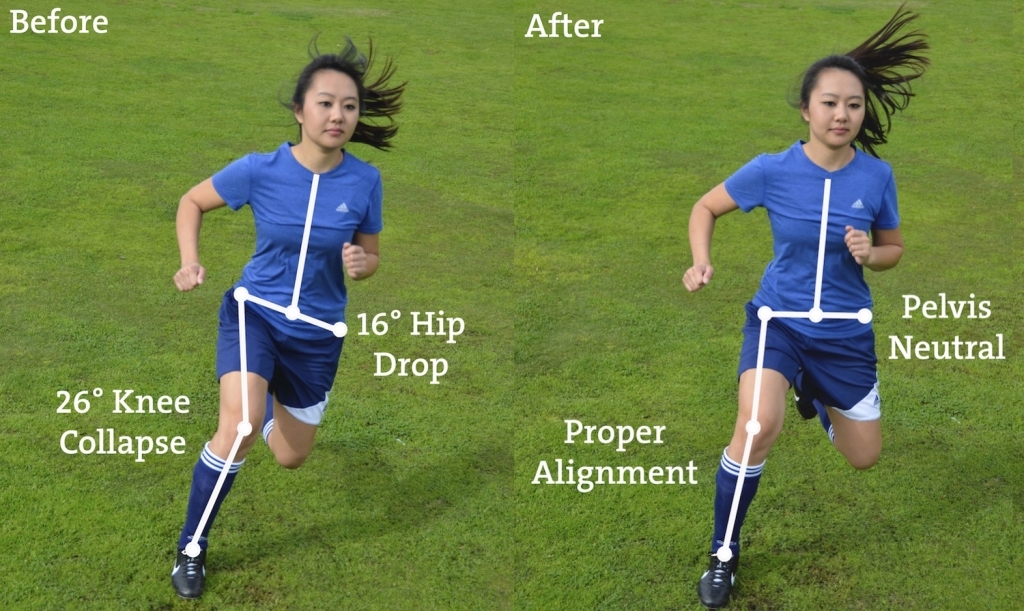Who Needs Knees? Why ACL injury prevention matters

The anterior cruciate ligament (ACL) is truly a crucial structure of your knee. It connects your femur (thigh bone) and your tibia (shin bone) and prevents excessive movement, improving the joint’s stability. ACL injuries are one of the most common knee injuries, especially among athletes. There are approximately 80,000 to 250,000 injuries per year with 100,000 reconstructions performed annually.[i]
The integrity of the ACL can be compromised by direct contact mechanisms – such as a blow from behind the knee forcing it to hyperextend, or a strong force striking from the side, causing the knee to move inward. Most of us can conjure images of football players knees buckling after getting tackled hard from behind or sideways. Surprisingly though, direct contact mechanisms are far less common than non-contact mechanisms, which make up 70% of all ACL injuries.1 Athletes whose sports involve pivoting and cutting like soccer, rugby and football; or jumping such as volleyball are heavily impacted.
ACL injuries can occur to any population or age group, however females and young athletes are specifically at a higher risk. Depending on the sport, current research shows that females incur ACL injures approximately 2-8x more than males.1 Research is showing that ACL tears among children and teens has increased about 2.3% per year for the past two decades, with the risk for females peaking at age 16 and for males at 17.[ii] Data from a pediatric center in Boston found that between 2000-2009, ACL injuries accounted for 10.6% of all knee injuries in 13 to 17-year-olds reported during the 9-year period[iii]. Another study conducted in New York state looked at ACL reconstruction rates over 20 years (1990 to 2009) and found that ACL reconstruction occurred eight times more in 15 to 18-year-olds than in 11- to 14-year-olds.3
Yikes! What do all these numbers mean? They mean that if we, or the young people in our lives, want to be or become healthy active adults, then we need to figure out how to prevent these injuries to start with rather than becoming another statistic. The good news is that proven ACL injury prevention practices exist.
So what can we do to prevent injury?
I’m glad you asked! Training young athletes before they get injured to re-program their control, coordination, and balance, while also addressing movement limitations has been shown to greatly reduce injury risk. The American Academy of Pediatrics has reported, “Neuromuscular training appears to reduce the risk of injury in adolescent female athletes by 72%. Prevention training that incorporates plyometric and strengthening exercises, combined with feedback to athletes on proper technique, appears to be most effective2.” Studies have also found that programs that integrate these components into training, significantly improves lower extremity and abdominal strength, vertical jump height, estimated maximal aerobic power, speed, and agility.[iv] In other words, not only will programs that address motor control training with plyometric, agility and strength activities, reduce the risk of ACL injuries, but they can also elevate the level of sport performance. (Athletes, parents, and coaches – we all like the sound of that, right?!).
Ok! I see why it’s important to prevent ACL injuries, but where can we go for help?
The Physical Therapists at Stride Physio can perform individual sport screens to identify mechanical risk factors, and improve your movement and sport performance by addressing muscle imbalances and poor control patterns. They are also trained in administering ACL injury prevention programs such as the one developed by Seattle Pediatric Sports Medicine (SPSM).
SPSM is an organization of local medical professions (including PTs and orthopedic physicians) who are committed to improving pediatric sports medicine. Recently, the members of SPSM have developed a program that was designed to both reduce the injury risk as well as to help achieve optimal performance in individuals of any age. The program is focused on improving dynamic mobility, strengthening, motor control and agility.
If you are interested in learning more about the SPSM ACL injury prevention program check it out here: http://seattlepediatricsportsmedicine.com/. Downloadable tools from the website are available complete with step-by-step instructions. However, it is strongly suggested that a Physical Therapist be utilized as a resource for athletes, coaches and supportive staff to ensure that proper motor control (not just completion of exercises) is achieved to reach optimal impact.
Have more questions or want to take action on reducing your or a loved one’s injury risk? Contact us!
By Mylan Vu, PT, DPT, OCS, MTC, CAFS
SPSM ACL injury prevention task force member.
References:
[i] https://www.orthopt.org/ICF/Knee%20Ligament%20Sprain%20-%20JOSPT%20April%202010.pdf
[ii] http://www.aappublications.org/news/2017/02/22/ACLTear022217
